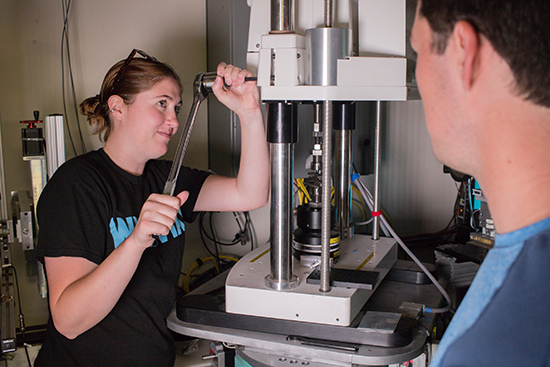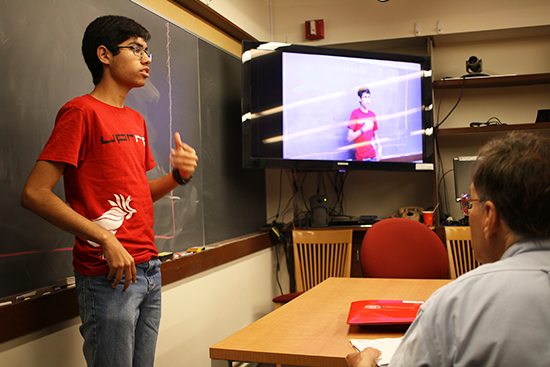X-RAY RUNS: Apply for Beamtime
2017 Nov 1 - Dec 21
2018 Feb 7 - Apr 3
2018 Proposal/BTR deadline: 12/1/17
2018 Apr 11 - Jun 4
2018 Proposal/BTR deadline: 2/1/18
For many undergraduate students, the idea of spending the summer away from friends and family to work at a state-of-the-art synchrotron radiation facility under the supervision of a research scientist is an intimidating prospect. In an effort to encourage a more diverse pool of students to participate in summer research programs, CHESS has adopted a new model for supporting students when they leave their own college campuses during the summer. The Summer Undergraduate Research in Science and Engineering (SUNRiSE) program brings students and faculty members from their home institutions to Cornell University for the summer months, offering opportunities for visiting faculty to conduct their experiments on CHESS beamlines and allowing students the chance to participate in cutting-edge research at the laboratory.
For the past two summers, CHESS has been funding summer research opportunities for undergraduate students nominated by Cornell or other visiting faculty members that advance the long-term research missions of the laboratory. These students, many of whom attend public liberal arts colleges or minority serving institutions, spend the summer working with mentors on established research projects. Visiting faculty stay in Ithaca for four weeks while students stay a total of eight weeks, living in a common residence hall and infusing themselves into student life on campus. In addition to collecting and analyzing beamline data, students participate in informal discussion with their peers, attend talks and tours highlighting the research facility, and practice their science communication skills through presentations to colleagues and public audiences.
Devin Leahy, visiting faculty mentor from Ft. Lewis College, Durango, Colorado advised his three students Elizabeth (Libby) Endersbe, James (Mac) Greene and Rachael Helvoigt on the development and validation of a finite element model to follow points on an actively-loaded titanium beam, enabling diffraction X-ray scan points to follow a specific region of material as the stresses change. CHESS graduate student and advisor Chris Budrow also worked with the students during the summer, overseeing the students as they designed a load frame to test the finite element model. Students worked on methods to repeatedly mount a sample, calibrate the load frame, and align a sample that is in the load frame. “Working on a problem with no known answer has been an experience much different from coursework,” said Leahy. “The SUNRiSE program has offered these students great practice for the real-world.”
 CHESS graduate student Chris Budrow oversees Fort Lewis College student, Rachael Helvoigt as she adjusts one of the CHESS load frames. She and the other Fort Lewis College students helped design a new load frame as part of their summer project.
CHESS graduate student Chris Budrow oversees Fort Lewis College student, Rachael Helvoigt as she adjusts one of the CHESS load frames. She and the other Fort Lewis College students helped design a new load frame as part of their summer project.
In his role as a mentor and research advisor, faculty member Mitk’El Santigo (Universidad Metropolitana at San Juan, Puerto Rico) trained his summer undergraduate student Suheily Alonso using the synchrotron to conduct X-ray spectroscopic observations under actual operation conditions with the aim of revealing the chemical basis for advanced metal-oxide fuel cell applications. “This program has helped Suheily to fully continue her research studies and motivated her to apply to graduate school in the near future,” says Santiago. “At first, she was a little nervous and shy, because Spanish is her native language. However, since she has been working in Hector Abruña’s laboratory I have witnessed that is no longer an issue. She is fully motivated to continue in this research and in the future to write her first scientific paper of this research.”
Carlos Cabrera, also from UPR Rio Piedras, has spent the first part of his summer mentoring UPR freshman Daniel Blasini-Peréz, researching alkaline fuel cell catalyst design using X-ray absorption spectroscopy. Blasini-Pérez is hoping to follow his father's educational path: graduating from UPR, attending Cornell University for graduate school and working at CHESS.
 Daniel Blasini-Peréz presents a 3-minute summary of his research project to date to his summer research peers and CHESS faculty advisor Carl Frank. His presentation was simulcast in real-time to students at Norfolk State University.
Daniel Blasini-Peréz presents a 3-minute summary of his research project to date to his summer research peers and CHESS faculty advisor Carl Frank. His presentation was simulcast in real-time to students at Norfolk State University.
During the SUNRiSE program, the nanostructured catalysts developed by Dr. Santiago and Dr. Cabrera have been geared towards the “oxygen reduction reaction (ORR)” for in operando X-ray absorption spectroscopy studies at CHESS with plans to submit a proposal to use the beam line facilities in the upcoming year. Currently, Drs. Santiago and Cabrera are preparing a NSF-Partnership for Research and Education in Materials (PREM) proposal in collaboration with CHESS to fund future research and education projects for UPR undergraduate students. This SUNRiSE model, a successful method of mentoring students from diverse backgrounds, will be included as part of these future plans.
Submitted by: Lora Hine, CHESS, Cornell University
07/13/2017
